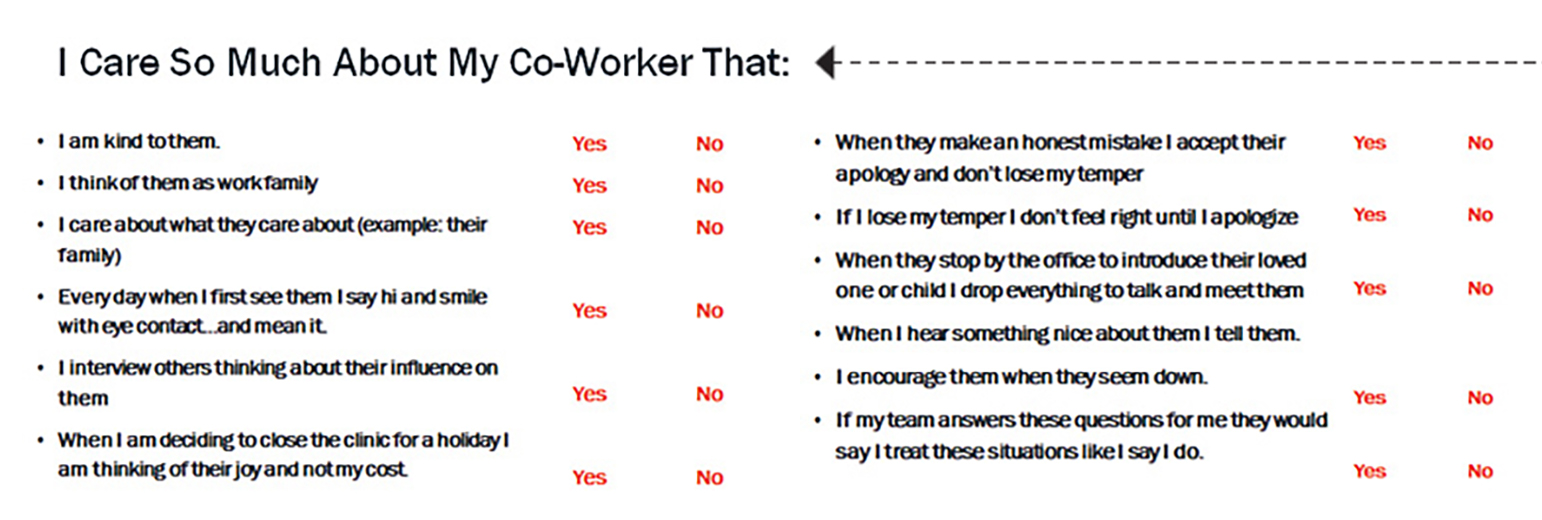

Everybody wants world-class customer service—you know, that white-glove service approach. Because refractive surgery practices provide high-end services, we must have a service-with-a-smile approach and the mentality that “the customer is always right.”
But to really get to the heart of a good customer service program requires some heavy lifting on the inside of your practice first. It’s true: Real customer service begins with hard work within your own four walls.
Creating a customer experience for your patients that builds word of mouth is all the rage in business today. Whether in health care, the financial services industry, or retail, everyone is clamoring after providing what the customer truly wants.
That said, the only way to achieve what the customer wants is to create a culture in which team members are keenly in tune with making the customer’s dreams come true. To say it differently, you can’t have a world-class customer service approach unless you have a world-class team approach. The best patient experience begins with the best team experience.
PATIENT FIRST, TEAM FIRST
It’s all about people. To thrive in modern-day business requires having a patient-first mentality. But to truly attain this mentality, practices need to develop a team-first mentally. What do we mean by this? Well, in a practice such as Vance Thompson Vision, where the surgeons are renowned for their great bedside manner, it can be difficult to create an environment in which the team interacts with the patient in the same way that the doctor-leaders do.
Just think about how powerful an organization could be if, rather than our 10 providers being the only ones focused on a great patient experience, all 130 members of the team were equally committed to creating a patient-first culture. That is when things begin to gel. When the team comes first in the team members’ training and priorities, the patient naturally becomes the focus of attention for far more people. To be team-first is to be patient-first.
This is what is required in a refractive surgery mindset. The refractive surgery mindset was born in the LASIK days, when patients were largely paying cash out of pocket for services rendered. Well, with deductibles as high as they are today, all patients now are elective or cash-pay patients. In the United States, for instance, deductibles average between US$5,000 and US$8,000, so even patients with the most traditional medical needs and coverage typically have a high amount of cash pay required of them for services rendered.
This means that, no matter what sector of eye care we are in, we need to have the same kind of mentality we had in the early days of LASIK: the white-glove approach. This is true not only for the patient but also, more important, for the team.
So here is the question: Is your team world-class? How much time is dedicated to training the team, not only in the skills required for their craft, but also in the soft skills required to serve your patients with a bedside manner that meets or exceeds your standard of care?
TRAINING
In order to develop an amazing team culture, your organization must commit to training. We need teams that are among the most highly trained on earth. It’s easy to look across the landscape of business today and find companies that do a good job of creating outstanding customer experiences, such as Disney, Apple, Tiffany, and Ritz-Carlton. What do these organizations have in common? Their products or services are typically elective in nature, and, yes, they are higher-end products or services.
But another trait they have in common is more subtle: They are all committed to world-class training. The training done by these organizations is top-tier. Do we have the same commitment to training as organizations like these do? If not, why not—especially when our offerings are typically 10 times more expensive than their average offerings? Consider the guidelines outlined below when you think about how to approach your team.
CREATING A WORK FAMILY
Training isn’t the only element required to create a winning team culture. Creating a winning team culture also requires creating an environment of work family. For many years, having friendships in the workplace was frowned upon. No longer. As described in Forbes in 2013, we have found that a key indicator of retention in a program like ours is whether or not team members identify a best friend at work.1
To properly treat our team like a work family, we create multiple opportunities for our team members to socialize, get to know each other, and become friends (Figure 1). We do this every day at our 10-minute daily huddles. These meetings, led by members of our team, are required for all team members who are not directly in front of a patient at that moment. Our other practice locations can log in via high-definition video as they see fit. We call these meetings our holy huddles because they are set aside, they are never missed, and they are sacred. These brief meetings cover topics from how to harmonize queues to how to properly greet people in social situations, along with traditional skill-development topics related to our craft.

Figure 1. Team-building at Vance Thompson Vision.
Although the training we do in these meetings is key, what is more important is that the team recognizes how important alignment is in an organization of our size. They see firsthand our doctors’ commitments to making sure we are all on the same page. These meetings happen every day we are open at Vance Thompson Vision.
Additionally, we have quarterly all-staff meetings where we take a deeper dive into topics that affect our business. One topic that is always high on the list of content for these meetings is how we can treat each other with more respect and honor as a work family (Figure 2).

Figure 2. Example of a staff questionnaire to promote the idea of work family.
In addition to these small and larger meetings, we host monthly social outings with the team members and their families. These activities can range from sledding at a nearby hill to meeting everyone at a local bar after hours.
The point of all these activities is simple: When we spend time together outside of work, we tend to grow in our affection for one another. Growth in affection leads to covering for one another and digging in to protect one another. This is what we mean by work family.
KEEP IT IN MIND
Other contributors in this cover focus will discuss additional tactics to directly enhance the patient experience. Their ideas are all good, and practices should take note of their innovation and creativity—we know we will. However, as you read ahead, keep in mind how important it is to see all of these ideas through the eyes of your team. If you can train your team to model the behavior you wish you could receive in a health care environment, you will multiply your influence and be a force for good that will make your organization an incredible place to call home.
White-glove treatment? To get there takes work gloves.
1. Clark D. Debunking the ‘No Friends At Work’ rule: Why friend-friendly workplaces are the future. Forbes. May 21, 2013. https://www.forbes.com/forbes/welcome/?toURL=https://www.forbes.com/sites/dorieclark/2013/05/21/debunking-the-no-friends-at-work-rule-why-friend-friendly-workplaces-are-the-future/&refURL=&referrer=#2668136a7501. Accessed May 23, 2018.


